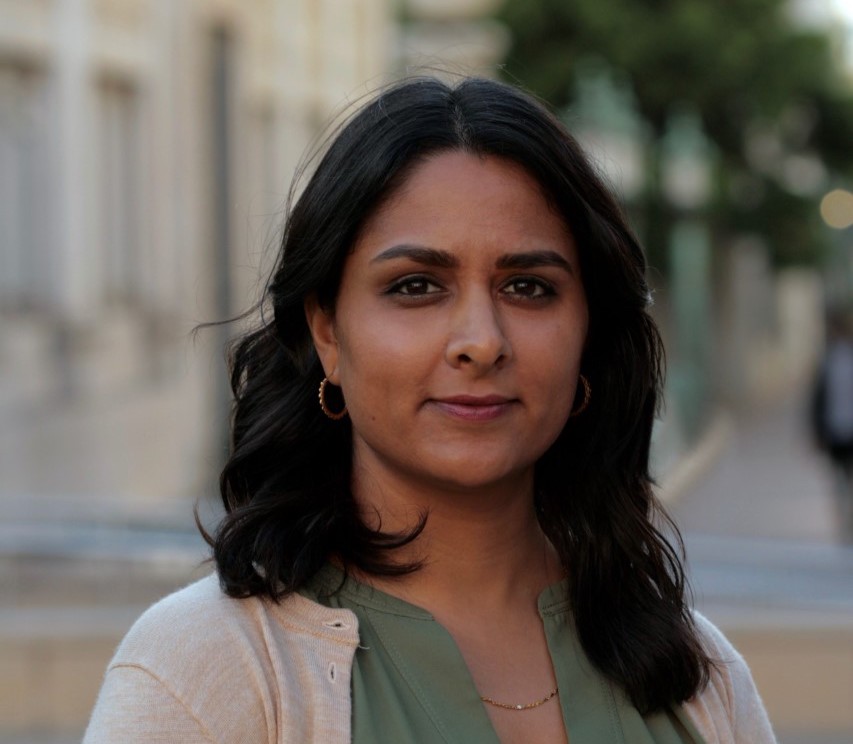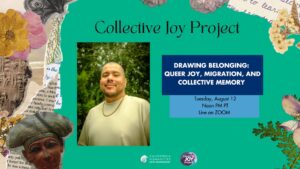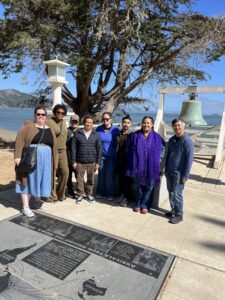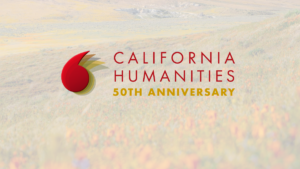This month we spoke with California Humanities board member Neha Balram, Program Analyst in the Cultural Affairs Division at the City of Oakland, about her dual roles with our organization, the concept of belonging as part of urban development, and bringing up baby with a variety of cultural experiences.
You bring a unique perspective to the California Humanities board, having been an employee for almost five years. How has your experience of being inside the organization informed your efforts as a board member and public humanities ambassador?
I started working at California Humanities in 2014 in an entry-level position. Back then, I couldn’t imagine becoming a board member. Leaving California Humanities for the City of Oakland’s Cultural Affairs Division was bittersweet—I was excited about the opportunity to work in local government but cared so deeply about the work of California Humanities. So, when I was nominated to join the board and stay connected, I was absolutely thrilled. It has also been a valuable building block in my professional development.
While on staff, I learned a lot, changed titles a couple times, and expanded my responsibilities. I worked on our federal and state advocacy efforts, started a rotating exhibit series, and provided administrative support to the board, among other things. I loved, lived, and breathed the public humanities. I can tell you all about the fabulous work our nonprofit cultural leaders across the state are doing and the positive impact they have on communities both big and small, seen and unseen, familiar and unfamiliar. I understand the hurdles small nonprofits overcome to get the job done, how racial and cultural diversity are celebrated through the public humanities, and the power of bringing people together to experience our unique similarities and differences.
I joined the board with an existing appreciation for my former colleagues, their commitment to the organization’s mission, and the attention and respect they give hundreds of applicants and grantees despite their limited capacity. I value those conference room conversations around how to thoughtfully adapt grantmaking and public programming during times of crisis, uncertainty, and change. I also learned quite a bit from observing past board members work together to support staff, push the organization’s goals forward, be present, and sometimes ask tough questions. When I transitioned from staff member to board member, I was well informed about who we were serving and what my new responsibilities were.
The City of Oakland published a Cultural Plan a few years ago that has the tag line “Equity is the Driving Force, Culture is the Frame, and Belonging is the Goal”. Can you tell us more about how this plan was developed, how it is being implemented, and ways that you have seen the central theme extend throughout city government?
“Belonging in Oakland: A Cultural Development Plan” was adopted by the Oakland City Council in 2018 as the City’s first cultural plan in 30 years. It was written after the Cultural Affairs Division Manager Roberto Bedoya was hired with research led by Vanessa Whang (A former California Humanities staff member. Small world!). The document is a roadmap that supports and lifts up the role of culture in building a just and equitable city–so that every Oaklander in every neighborhood has access to cultural amenities. The Cultural Development Plan included a research and discovery phase as well as robust community engagement.
The Plan laid out several action items including the creation of my position, which is responsible for re-establishing and managing the Cultural Affairs Commission, a volunteer body appointed by the mayor to be community advocates for Oakland’s arts and culture. Additionally, the Cultural Affairs Division launched a new grant program (Neighborhood Voices), developed an artist in residence program (Cultural Strategists-in-Government), hired of a (temporary) Policy Director of Arts Spaces, and a conducted a cultural and racial equity impact analysis of current programs, policies, and procedures and explore asset-based approaches.
One of the biggest challenges for the field of arts, humanities, and culture is convincing elected officials and policymakers to invest in working artists and culture keepers beyond K-12 education. Tight budgets and higher priorities consistently leave arts, humanities, and cultural programming malnourished. This is where the Cultural Strategists-in-Government Program is a step in the right direction for the City of Oakland. The pilot program was launched in 2018 and has returned in 2022 for a second round with a significant increase in department participation. This program currently funds ten artist-in-residences placed in various city departments to infuse policymaking and practices with new creative and culturally competent thinking and problem-solving to promote civic belonging and well-being.
On an international level, In the Banlieues/Centering the Margin: Oakland/Saint-Denis, a project co-produced by California Humanities and involving City of Oakland artists, leaders and policymakers in conversation with their French counterparts, is another recent example of how the arts and humanities can and should be included in conversations and visioning around urban development.
Your professional and community work has always been at the intersection of the arts and humanities. How would you describe the impact of aligning these two fields, and what are your hopes for the future?
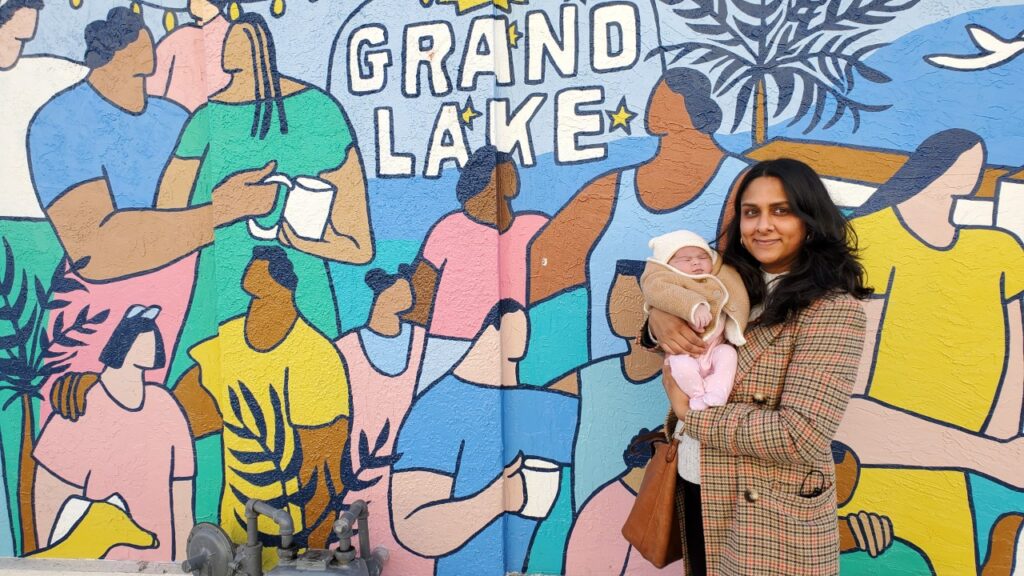
I’ll take this moment to reflect on my personal future and how the arts and humanities intersect in my newest role as “mumma” to my 11-month old daughter, Neela. This past weekend I bounced around from two different cultural celebrations—Diwali and Día de los Muertos—both bursting with traditional clothing, visual art, food, music, storytelling, and family. Diwali is a Hindu festival I’ve celebrated my entire life, while Día de los Muertos is a less familiar yet captivating celebration that I have no ethnic or cultural connection to. Neela is new to it all. When I think about her education, the arts and humanities are at the center—they are essential tools for cultural preservation and understanding and a significant part of my professional life. I’ll cherish the memory of this particular Diwali because it involved several of Neela’s “firsts” that I helped facilitate—her first Indian outfit, her first time smelling sandalwood and rose incense, and her first time listening to me read the Ramayana. Culture gives me a feeling of connectedness to my ancestors and loved ones; it gives me a sense of belonging and helps me understand and appreciate who I am, which is my hope for Neela. I also hope that unfamiliar cultural experiences will be magical opportunities for her to learn and appreciate something new. I hope that as she gets older, she asks me to take her to the Día de los Muertos festival and other cultural events. I hope she enjoys watching others celebrate their own culture, shares in those experiences, and learns to appreciate our differences and similarities.
*Featured photo courtesy of Neha Balram
